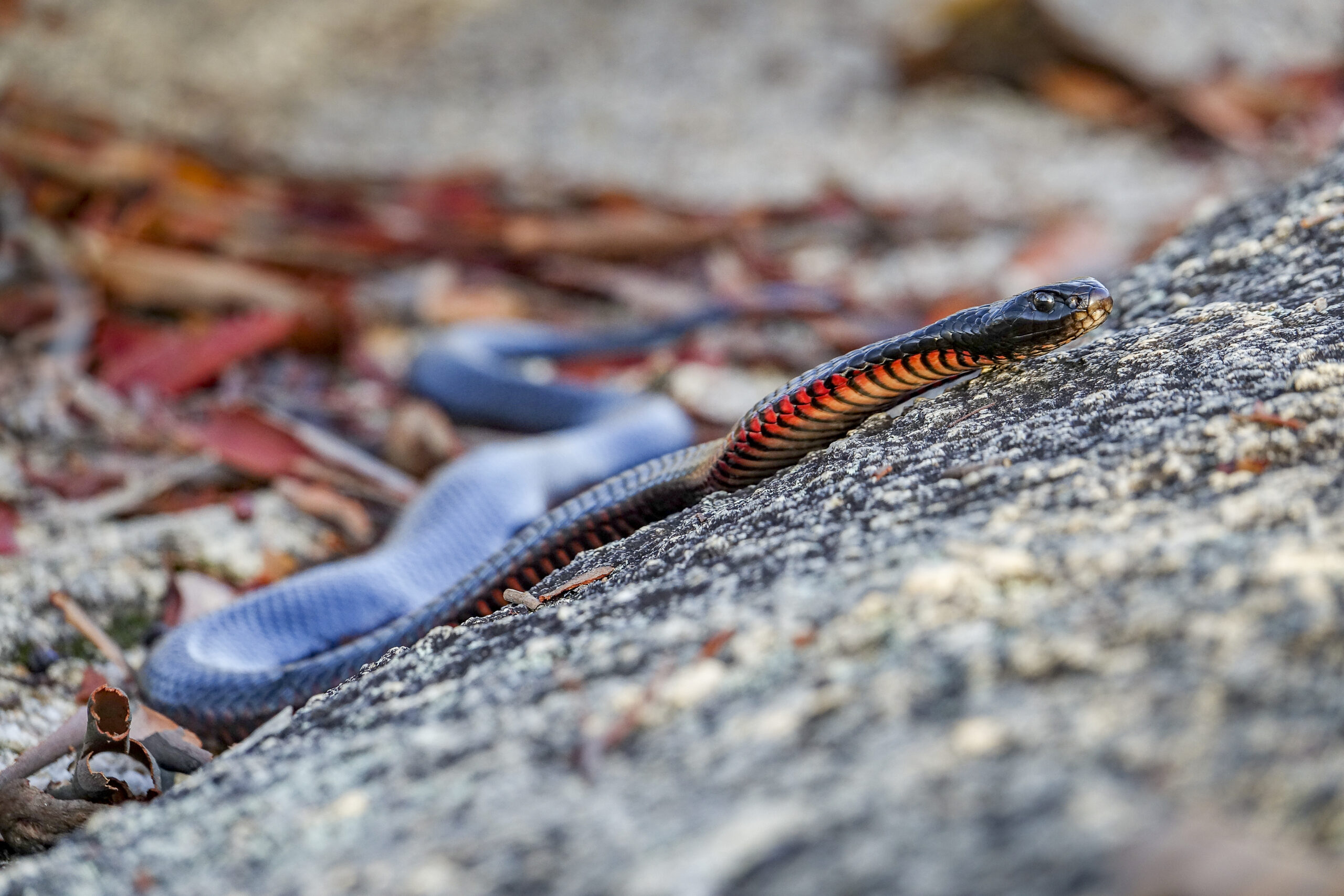
A Red-bellied Black Snake enjoys the morning sun following a stormy night at Girraween National Park.
Red and black, always a great colour scheme — and certainly an arresting one when you are out walking and the colours belong to a Red-bellied Black Snake.
Bushwalkers who know their stuff are always scanning around them as they walk, keeping one eye open lest a boot should land unwittingly on one of the scaly creatures who share the bush with us. Encountering one of these spectacular red and black snakes while walking will always pull you up a bit short — seeing one in the wild is always memorable. Like all snakes, ‘Red-bellies’ are mysterious and fascinating things. My heart may skip a beat if I stumble upon one unexpectedly, but that is soon replaced by the excitement of having the chance to observe one of these beautiful reptiles doing its thing.
Red-bellied Black Snakes (Pseudechis porphyriacus) are found along the east coast of Australia, where they live in woodlands, plains and urban bush, even being found in Brisbane, Adelaide, Cairns, Melbourne, Sydney and Canberra.
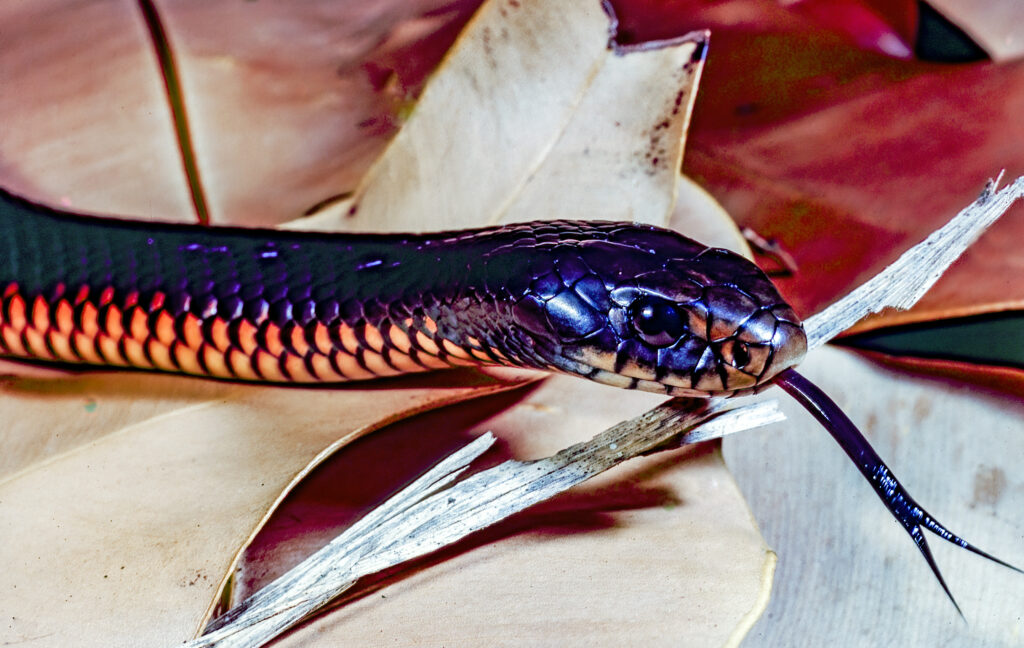
Like all snakes, the Red-Bellied Black has a forked tongue, which it uses to ‘smell’. By flicking its tongue in the air, a snake can collect odour-causing particles that it then delivers to a sensory organ in its mouth.
This species has other common names — redbelly, RBBS, common black snake. It is known as djirrabidi to the Eora and Darug First Nations people of the Sydney basin.
Red-bellied Black Snakes can grow to about two metres in length. They like to live near water and can usually be found around river and creek banks, swamps and wet forests. They seem to prefer areas that have shallow water with logs, water plants and other debris. While they like water, they can travel about 100m from their favourite retreat, and turn up in nearby backyards.
The English naturalist George Shaw described The Red-bellied Black Snake in Zoology of New Holland in 1794, giving it the scientific name Coluber porphyriacus. It was the first Australian elapid snake to be scientifically described. Shaw thought the species was not venomous, writing, “This beautiful snake, which appears to be unprovided with tubular teeth or fangs, and consequently not of a venomous nature, is three, sometimes four, feet in nature.”
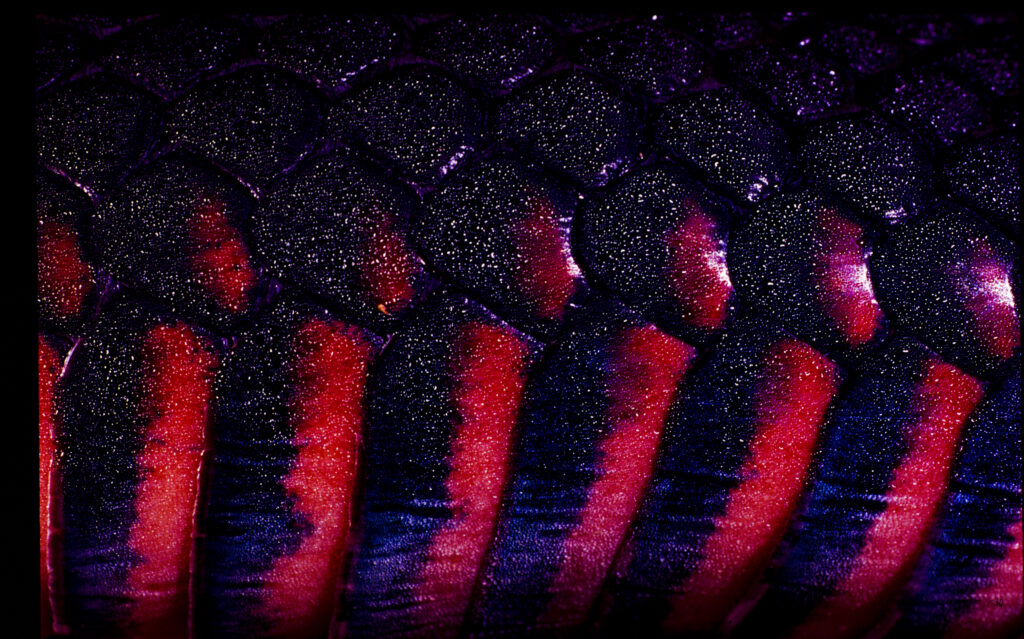
The species name (Pseudechis porphyriachus) is derived from the Greek word ‘porphyrous’, which can mean ‘dark purple’, ‘red-purple’ or ‘beauteous’
While actually highly venomous, Red-bellied Black Snakes are quite shy animals, and will flee from humans whenever possible. This has certainly been my experience. Want a long and animated chat, though? Ask a group of people about snakes chasing humans — there wll be no end to the stories of scary pursuit by determined snakes!
Despite its reputation for being aggressive and highly dangerous, this elegant snake is inoffensive and reluctant to bite. Though it is rightly considered to be potentially dangerous, there are no proven human fatalities despite its occurrence along the populated eastern seaboard. — ‘What Snake is That?’ Gerry Swan and Steve Wilson
Yes, people do get bitten by them. Early settlers feared the species, though it turned out to be much less dangerous than many other snakes. The snake’s venom contains neurotoxins, myotoxins, and coagulants and also has haemolytic properties. Bites from Red-bellied Black Snakes can be extremely painful and result in prolonged bleeding, swelling and even local necrosis.
This species accounted for 16% of identified snakebite victims in Australia between 2005 and 2015. However, over that time no deaths were recorded.
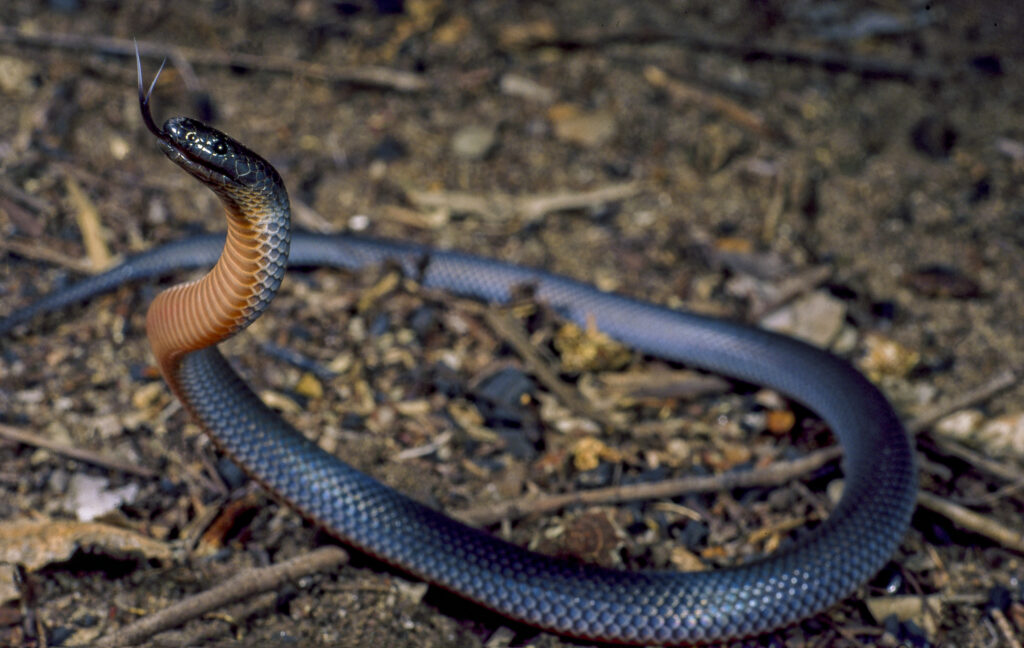
Juvenile Red-bellied Black Snakes are similar to the Eastern Small-eyed Snake (Cryptophis nigrescens). The latter species (photographed here at Isla Gorge National Park) lacks the Red-bellied Black Snake’s red flanks.
Red-bellies are active by day (unlike other black snakes). They eat frogs, fish, reptiles (including other snakes) and small mammals. While numbers have declined in areas where cane toads are present, the species seems to have developed increased resistance to toad toxin and decreased preference for toads as snacks. They search widely for prey, sometimes hunting in water. When fleeing a predator, these snakes may stay submerged with just their head showing, or dive under completely for nearly 30 minutes.
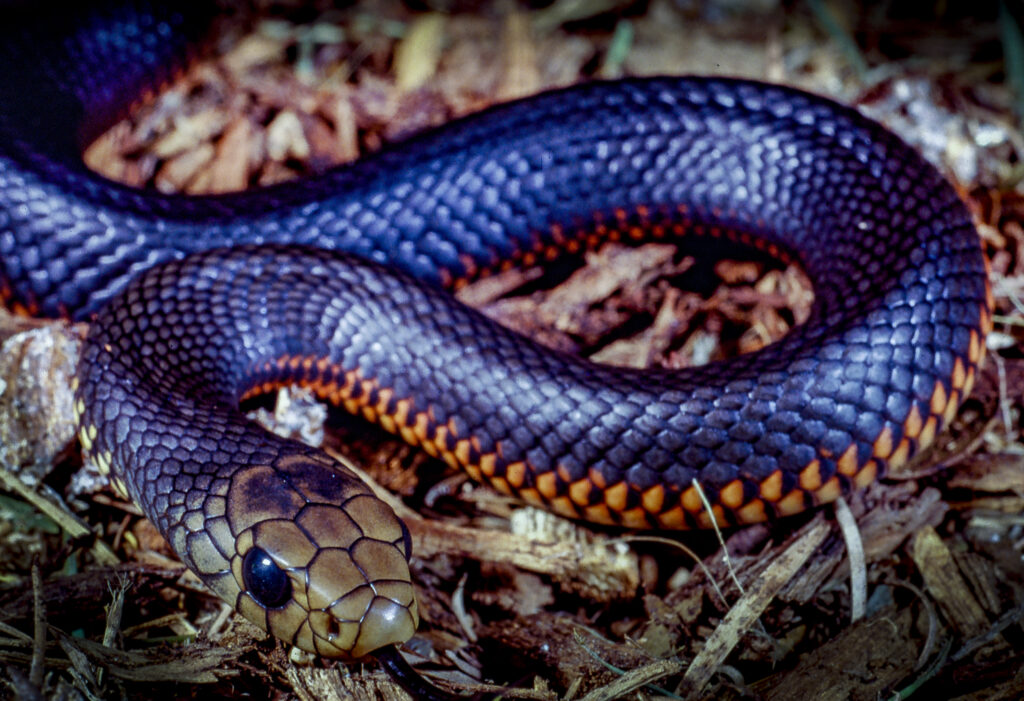
Snakes’ eyes are closed all the time. Rather than having moveable eyelids, snakes have a single, fused, clear layer of skin over their eye, called a spectacle or brille (German for “glasses”), which protects the eye. A snake’s skin is covered in scales, and the outer part of the spectacle is indeed a scale. The deeper layers of the spectacle are formed, during development, from the same embryonic tissue that in other animals forms the eyelid. The spectacle is not attached to the snake’s eye in any way, so the eye can move freely behind it, although its movement is limited. — Life is Short, but Snakes are Long.
It’s been said that this species eats the more dangerous Eastern Brown Snakes, and thus if Red-Bellied Black Snakes are present, brown snakes will not be. This is a myth, as while Red-bellies may eat the occasional brown snake, they usually prefer very different habitats. Black snakes are apparently immune to the venom of brown and other venomous snakes, as they have been observed receiving multiple bites from their venomous prey without apparent ill effect.
During the spring breeding season males actively search for females and may engage in ritualised combat. They wrestle vigorously, but rarely bite, engaging in head-pushing contests, where each snake tries to drive his opponent’s head downward with his chin. Mating activity occurs during spring and mid-summer, and five to nineteen live young are born between October and March.
While the Red-belly is not considered to be endangered, its preferred habitat has been reduced and fragmented by urban development. I knew they lived quietly in a small patch of creek-side vegetation where I lived in Brisbane for years, causing no offense, living on the equally beautiful Graceful Tree Frogs, until one day the area was flattened for housing, and neighbours began to complain of the plague of evil black snakes. They were of course forced to seek other habitat, one even turning up in my backyard, where it sought shelter near an old bath-tub we’d turned into a frog pond. I dearly wished I could flatten some of the new houses and return the place to swamp.
There has also been a decline in frogs, this reptile’s favourite prey, across eastern Australia. Red-bellies are in turn eaten by kookaburras, brown falcons and other raptors, as well as cats. They don’t cope well with roads and cars.
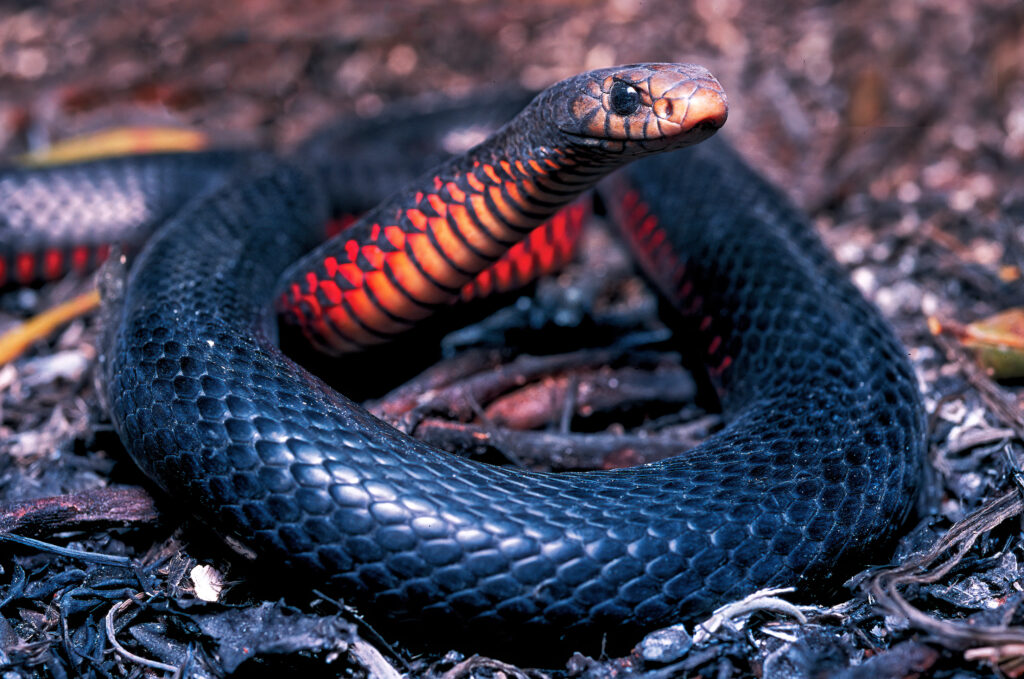
Red-bellied Black Snake, found sheltering after a wildfire in a bush reserve at Lota, Brisbane.
This beautiful serpent shares our love of sunshine and water and is a familiar sight to many outdoor adventurers in eastern Australia. Attitudes towards these largely inoffensive snakes are slowly changing, however they are still often seen as a dangerous menace and unjustly persecuted. — The Australian Museum
[All photos by Robert Ashdown. However, the first photo in this post taken on the camera of friend, and fellow walker, Raelene Neilson. I was walking without one of my own cameras (go figure). Thanks heaps, Raels, for the camera and for the many memorable shared walks in the bush.]

Great article Rob good to be writing again
I always think it’s a privilege to see any snake but these beautiful creatures are one of my favourites
Thanks, Greg! Hope you are well. Cheers, Rob.
What a fascinating read, Rob! Thanks for sharing such an informative post with excellent shots. Aren’t these creatures just marvelous? I’m constantly on the lookout for snakes on my walks, but so rarely see them. Red-bellied blacks are one of my favourites.
Yeah, they are one of my favourites, too. Such unusual and dramatic creatures. The Australian bush is a marvellous place, with some real reptilian characters hanging about!